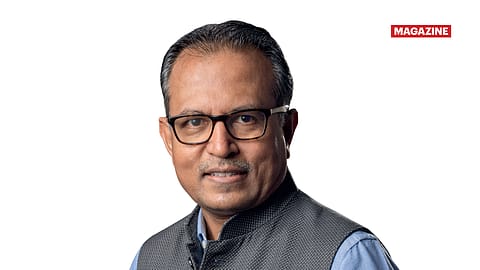Market guru Nilesh Shah’s compelling advice: Yes, storm clouds are gathering, but disciplined investing will prevail
A disciplined approach for the long term will help navigate it.

This story belongs to the Fortune India Magazine July 2025 issue.
THE RUSSIAN SAYING, “May you live in interesting times,” feels like a fitting lens to view global and Indian equity markets today. The world is in constant flux, moving from one uncertainty to another, with geopolitical and geo-economic factors evolving at a dizzying pace. While domestic fundamentals, capital flows, and investor sentiment remain supportive of India’s markets, global headwinds create a complex backdrop.
The global financial landscape is fraught with vulnerabilities, particularly in the U.S., which remains the linchpin of the world economy. With $37 trillion in national debt, $8 trillion in debt-servicing costs (FY25), a $2 trillion fiscal deficit, and a $1 trillion current account deficit, the U.S. economy is skating on thin ice. The gradual erosion of the U.S. dollar’s status as the world’s reserve currency adds to the complexity. These factors raise the spectre of a potential crisis reminiscent of the 2008 subprime meltdown. The transition in U.S. leadership, with President Donald Trump’s policies shifting from ‘Make America Great Again’ (MAGA) to what some critics call ‘Trump Always Chickens Out’ (TACO), introduces further unpredictability. The Hindi phrase, Don ko samajhna mushkil hi nahi, namumkin hai (It’s not only difficult, but impossible to understand the Don), captures the uncertainty surrounding U.S. policy direction. Trump’s policies, combined with economic vulnerabilities, are likely to push capital flows out of the U.S., into emerging markets, including India, where long-term growth prospects remain robust.
India’s equity markets are not without their challenges. Valuations, particularly in the short term, are demanding, with high price-to-earnings ratios reflecting optimism about future growth. Smart investors focus on long-term earnings potential, rather than wait for a market correction. Large- and mid-cap companies showcased strong earnings in Q4FY25. Small-cap results, however, fell short, though this disappointment is seen as a deferment rather than a cancellation of growth. Analysts project high single- to low double-digit earnings growth in the foreseeable future, underpinned by India’s structural strengths — rising domestic consumption, infrastructure development, and policy reforms.
Despite the optimism, risks loom large. In the short term, oil remains a concern. The ongoing conflicts between Israel and Iran, as well as Russia and Ukraine, threaten both availability and prices. A spike in crude oil prices could strain India’s import-dependent economy, impacting inflation, fiscal balances, and corporate margins.
Long-term challenges
Global trends pose structural challenges in the long term. The shift from globalisation to protectionism is reshaping trade dynamics, with countries erecting barriers to safeguard domestic industries. The world is also transitioning from a unipolar to a multipolar order, complicating India’s geopolitical and economic positioning. Additionally, technological disruptions are widening the gap between innovators and followers. India, while progressing rapidly in technology, allocates only 0.6% of GDP to research and development (R&D). This is significantly lower than global leaders like China.
To stay competitive, India must significantly boost its R&D spending and foster a culture of innovation. The country is countering protectionism by negotiating bilateral free trade agreements (FTAs), and maintaining a delicate balance in a multipolar world.
More Stories from this Issue
The rise of MFs and themes
India’s investment landscape has undergone a remarkable transformation, driven by platforms and mutual funds. The Mutual Funds Sahi Hai campaign, spearheaded by the Securities and Exchange Board of India, has successfully converted speculators and direct traders into disciplined fund investors. MF investors are demonstrating a counter-cyclical behaviour — buying more through systematic investment plans (SIPs) and subscriptions in falling markets, and booking profits through redemptions in rising markets. This approach has stabilised flows into India’s equity markets, making them more resilient to global volatility.
From a sectoral perspective, consumer discretionary stands out as an attractive investment theme. Policy measures such as recurring tax rebates worth ₹1 lakh crore, a 100-basis-point rate cut reducing EMI burdens, and the upcoming 8th Pay Commission are set to boost disposable incomes. The wealth effect from rising gold prices could further fuel aspirational spending in areas, including travel, tourism, entertainment, consumer durables, education, and healthcare. These sectors are poised to benefit from a consumption-driven growth cycle.
The chemicals sector also presents compelling opportunities. As global supply chains move away from China, the domestic chemicals industry is well-positioned to capture market share. In contrast, the defence sector appears expensive, with valuations reflecting lofty expectations. Investors should approach this sector with caution, ensuring fundamentals justify the premiums.
(INR CR)
Tempering expectations
While India’s equity markets offer significant opportunities, investors must moderate their return expectations. Stellar returns of the past five years are unlikely to be replicated over the next five, given the fully valued nature of the market. A disciplined, long-term approach — focussing on quality companies with strong earnings growth and reasonable valuations — will be key to navigating this environment.
India’s equity markets stand at a crossroads, balancing domestic resilience and global uncertainties. While geopolitical tensions, oil price volatility, and U.S. economic vulnerabilities pose risks, India’s structural growth drivers — consumption, infrastructure, and policy reforms — offer a compelling case for long-term investors. Sectors, including consumer discretionary and chemicals, are poised for growth, but investors must remain vigilant about valuations and global developments. By adopting a disciplined, long-term approach and leveraging the stability of mutual fund investments, investors can navigate these “interesting times” with confidence. India’s equity markets, though not without challenges, remain a beacon of opportunity in an uncertain world.
(Views are personal. The author is MD, Kotak Mahindra AMC)